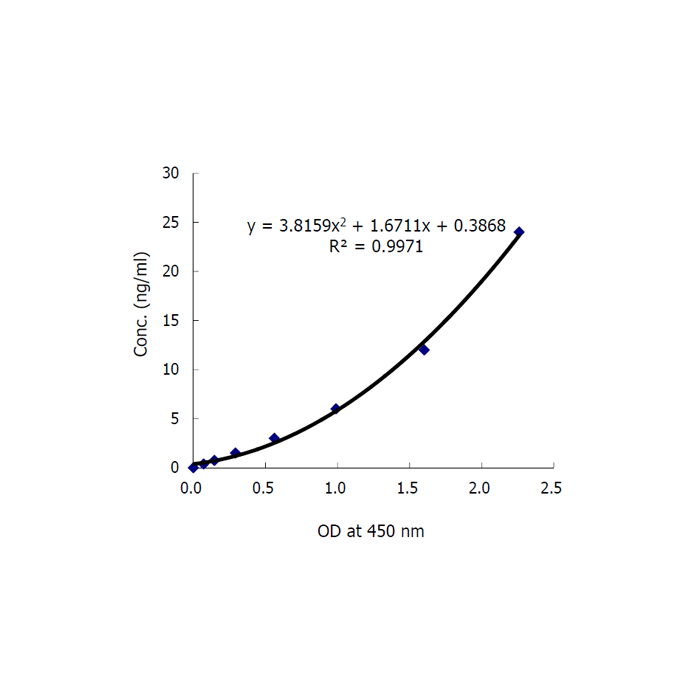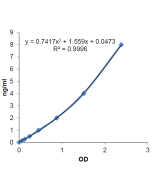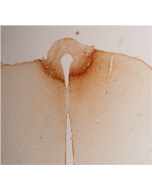Cookie Policy: This site uses cookies to improve your experience. You can find out more about our use of cookies in our Privacy Policy. By continuing to browse this site you agree to our use of cookies.
AdipoGen Life Sciences
Adiponectin (rat) ELISA Kit

| Product Details | |
|---|---|
| Synonyms | ACRP30; AdipoQ; apM1; GBP28; Adipocyte complement related protein of 30kDa |
| Product Type | Kit |
| Properties | |
| Application Set | Quantitative ELISA |
| Specificity |
Detects rat adiponectin. Does not cross-react with mouse adiponectin, human adiponectin, rat resistin, rat RELM-α or rat leptin. |
| Crossreactivity | Rat |
| Quantity |
1 x 96 wells |
| Sensitivity | 50pg/ml |
| Range | 0.375 to 24ng/ml |
| Sample Type |
Cell Culture Supernatant Plasma Serum |
| Assay Type | Sandwich |
| Detection Type | Colorimetric |
| Shipping and Handling | |
| Shipping | BLUE ICE |
| Short Term Storage | +4°C |
| Long Term Storage | +4°C |
| Handling Advice |
After standard reconstitution, prepare aliquots and store at -20°C. Avoid freeze/thaw cycles. Plate and reagents should reach room temperature before use. |
| Use/Stability | 12 months after the day of manufacturing. See expiry date on ELISA Kit box. |
| Documents | |
| Manual |
 Download PDF Download PDF |
| MSDS |
 Download PDF Download PDF |
| Product Specification Sheet | |
| Datasheet |
 Download PDF Download PDF |
Adiponectin [ACRP30; AdipoQ] is a promising biomarker of insulin resistance and type 2 diabetes mellitus (T2DM) but also as a potential target for management of the metabolic syndrome. It is a very robust marker that is not prone to degradation or acute inflammatory challenges, is present in relatively high concentrations in the peripheral circulation, and can be collected by a variety of methods. The benefits of using adiponectin assays in clinical settings include, (a) prediction of risk of diabetes and metabolic status and (b) providing a tool to monitor metabolic improvements. Adiponectin exerts anti-atherogenic and anti-inflammatory properties and may be important as a biomarker for obesity-related cardiovascular disease (CVD). New findings showed urinary adiponectin excretion as an independent new biomarker of microvascular and macrovascular damage in T2DM and suggested it as a very promising tool for early cardiovascular disease risk assessment. Adiponectin serum level was also described as a good biomarker of colorectal adenoma, this being related to the positive correlation between obesity and increased risk of cancer at various sites (colorectal, breast, prostate and endometrium).
- A new organotypic culture of adipose tissue fragments maintains viable mature adipocytes for a long term, together with development of immature adipocytes and mesenchymal stem cell-like cells: E. Sonoda, et al.; Endocrinology 149, 4794 (2008)
- The Lou/C rat: A model of spontaneous food restriction associated with improved insulin sensitivity and decreased lipid storage in adipose tissue: C. Veyrat-Durebex, et al.; Am. J. Physiol. Endocrinol. Metab. 296, E1120 (2009)
- Subcutaneous adipose tissue-derived stem cells facilitate colonic mucosal recovery from 2,4,6-trinitrobenzene sulfonic acid (TNBS)-induced colitis in rats: Y. Ando, et al.; Inflamm. Bowel Dis. 14, 826 (2008)
- Effects of aerobic exercise training on visceral fat and serum adiponectin concentration in ovariectomized rats: A. Damirchi, et al.; Climacteric 13, 171 (2010)
- Adipose tissue explants and MDCK cells reciprocally regulate their morphogenesis in coculture: K. Udo, et al.; Kidney Int. 78, 60 (2010)
- The role of hypothalamic AMP-activated protein kinase in ovariectomy-induced obesity in rats: Y.C. Tsai, et al.; Menopause 17, 1194 (2010)
- Effects of ovariectomy and estrogen replacement therapy on visceral adipose tissue and serum adiponectin levels in rats: P. Babaei, et al.; Menopause Int. 16, 100 (2010)
- Antioxidant and Hepatoprotective Effects of Silibinin in a Rat Model of Nonalcoholic Steatohepatitis: Y. Haddad, et al.; Evid. Based Compl. Alternat. Med. 2011, nep164 (2011)
- High-fat diet and glucocorticoid treatment cause hyperglycemia associated with adiponectin receptor alterations: C. de Oliveira, et al.; Lipids Health Dis. 10, 11 (2011)
- Grape seed extract supplementation prevents high-fructose diet-induced insulin resistance in rats by improving insulin and adiponectin signalling pathways: A. Meeprom, et al.; Br. J. Nutr. 106, 1173 (2011)
- Effects of adrenal hormones on the expression of adiponectin and adiponectin receptors in adipose tissue, muscle and liver: C. de Oliveira, et al.; Steroids 76, 1260 (2011)
- Role of AMP-activated protein kinase and adiponectin during development of hepatic steatosis in high-fat diet-induced obesity in rats: S.K. Ha, et al.; J. Comp. Pathol. 145, 88 (2011)
- N-acetylcysteine and allopurinol synergistically enhance cardiac adiponectin content and reduce myocardial reperfusion injury in diabetic rats: T. Wang, et al.; PLoS One 6, e23967 (2011)
- NCX 1000 Alone or in Combination with Vitamin E Reverses Experimental Nonalcoholic Steatohepatitis in the Rat Similarly to UDCA: Y. Haddad, et al.; Int. J. Hepatol. 2011, 136816 (2011)
- Maternal prenatal undernutrition programs adipose tissue gene expression in adult male rat offspring under high-fat diet: M.A. Lukaszewski, et al.; AJPEM 301, E548 (2011)
- Melatonin protects steatotic and nonsteatotic liver grafts against cold ischemia and reperfusion injury: M.A. Zaoualí, et al.; J. Pineal. Res. 50, 213 (2011)
- Calorie Restriction with a High-Fat Diet Effectively Attenuated Inflammatory Response and Oxidative Stress-Related Markers in Obese Tissues of the High Diet Fed Rats: S. Park, et al.; Med. Inflamm. 2012, ID 984643 (2012)
- Increased secretion of insulin and proliferation of islet β-cells in rats with mesenteric lymph duct ligation: K. Nagino, et al.; BBRC 425, 266 (2012)
- Alpha-lipoic acid prevents non-alcoholic fatty liver disease in OLETF rats: T.S. Jung, et al.; Liver Int. 32, 1565 (2012)
- Selenium Significantly Inhibits Adipocyte Hypertrophy and Abdominal Fat Accumulation in OLETF Rats via Induction of Fatty Acid β-Oxidation: J.E. Kim, et al.; Biol. Trace Elem. Res. 150, 360 (2012)
- Aqueous extract of Liriope platyphylla, a traditional Chinese medicine, significantly inhibits abdominal fat accumulation and improves glucose regulation in OLETF type II diabetes model rats: J.E. Kim, et al.; Lab. Anim. Res. 28, 181 (2012)
- Daidzein improves insulin resistance in ovariectomized rats: Y.K. Cao, et al.; Climacteric 16, 111 (2013)
- Ambient fine particulate matter and ozone exposures induce inflammation in epicardial and perirenal adipose tissues in rats fed a high fructose diet: L. Sun, et al.; Part. Fibre Toxicol. 10, 43 (2013)
- Anthocyanin-rich juice lowers serum cholesterol, leptin, and resistin and improves plasma fatty acid composition in fischer rats: D. Graf, et al.; PLOS One 8, e66690 (2013)
- Taurine alleviates the progression of diabetic nephropathy in type 2 diabetic rat model: J.H. Koh, et al.; Int. J. Endocrinol. 2014, IS397307 (2014)
- Attenuation of carotid neointimal formation after direct delivery of a recombinant adenovirus expressing glucagon-like peptide-1 in diabetic rats: S. Lim, et al.; Cardiovasc. Res. 113, 183 (2017)
- Anti-obesity properties of the strain Bifidobacterium animalis subsp. lactis CECT 8145 in Zücker fatty rats: N.L. Carreras, et al.; Benef. Micr. 9, 629 (2018)









